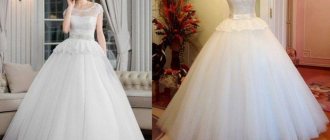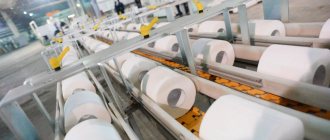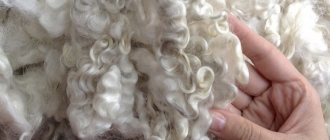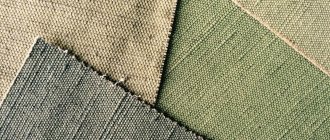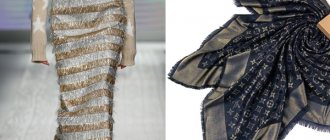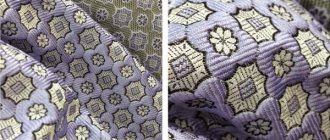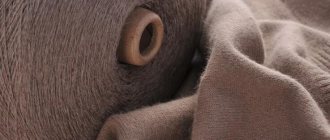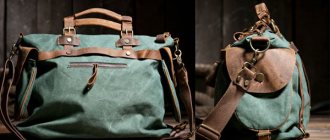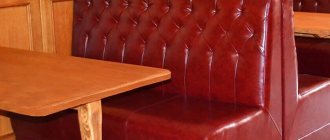What type of fabric is this?
Kevlar is a synthetic fabric with a crystalline structure. This material is durable due to the benzene ring located in the cross section of the crystal. Kevlar is stronger than metal in its properties.
This material is produced in America at the DuPont chemical plant. Kevlar production begins only when low temperatures are reached.
Kevlar colors
Calcium chloride and methylpyrrolidone are mixed, then reagents are added. All these substances enter into a chemical reaction, and a polymer is obtained that has the properties of liquid crystals.
The resulting polymer looks like a gel or fine crumbs. It is thoroughly washed, then dried and then dissolved in sulfuric acid. The resulting solution is passed through dies. The result is fibers. By twisting them, threads are created and fabric is obtained from them.
Kevlar: what is it anyway?
Fabric made of synthetic fiber with a crystalline structure is called Kevlar. The incredible strength of the fabric is given by the benzene ring, which lies in the cross section of the crystal. According to its characteristics, the material is stronger and more durable than metal, while it is very thin and light.
Kevlar fiber
Everyone gets to know Kevlar differently, and everyone learns what it is from certain life situations. Modern youth are familiar with the material thanks to the game Rast, in which characters are invited to purchase armor and ammunition from it. Older generations associate the fiber with protective clothing and sports equipment.
Types of Kevlar fiber
Briefly about the origin
Back in 1975, a material called Kevlar was first introduced to the market and immediately began to enjoy enormous demand, which is only increasing every day. This unique polymer was obtained in the laboratories of the world famous DuPont concern. Officially, chemist Stephanie Kwolek is considered its creator.
In those days it was used for tires as a reinforcing material. It subsequently found application in a variety of composite materials, sports equipment, and cable products. Kevlar fabric began to be used to produce personal protective equipment.
Kevlar thread
Origin story
Kevlar was created in America in 1964 at the DuPont chemical plant. The creator of this material is American chemist Stephanie Kwolek. Kevlar began to be produced on an industrial scale in 1970.
Initially, the material was created for reinforcing cables and tires for cars. Subsequently, the scope of application of Kevlar became extensive.
Kevlar fabric is a registered trademark of a para-aramid synthetic fiber.
History of the invention of Kevlar
This unique polymer, like many other synthetic fibers, was obtained in the laboratories of the world famous DuPont concern. Its official creator is chemist Stephanie Kwolek, head of a group working on the problem of synthesizing durable polymer fibers for tire reinforcement. In 1964, Kwolek proposed a new method for producing polyaramid threads - not from a melt, as for most polymers, but from a solution. Polycondensed para-aramid is dissolved in acid, and then opaque crystalline fibers of varying densities, having a yellowish-golden color, are grown from the solution; on average their thickness is approximately 11 microns. The crystal structure of such a fiber is a rod, in the cross section of which lies a benzene ring, which gives the structure very high strength . When testing the tensile strength of the first laboratory samples of polyaramid fibers, the researchers even decided that the equipment was faulty, since the resulting strength (up to 260 cn/Tex) turned out to be several times higher than that of steel, and moreover, the new polymers turned out to be flexible and lightweight. For further use, the fibers are twisted into a thread; their number in one thread may vary. Kevlar fabric is produced from threads with up to 1000 fibers; thicker threads (up to 10 thousand fibers) are used for technical purposes, for reinforcing various materials and for the production of ropes.
In 1975, a new ultra-strong polymer went on sale under the brand name Kevlar. It was, as expected, used as a reinforcing material for tires. In addition, it has found application for various composite materials, for the production of cable products, prosthetics, sports equipment, etc. The largest share of manufactured products is occupied by Kevlar fabric, which is used mainly for the production of personal protective equipment. Regardless of the form of release, polyaramid fibers and threads made from them have the following characteristics:
- high tensile and tear strength (cut);
- low density (30-60 g/sq.m);
- increased strength when the temperature drops down to -200 degrees;
- high elasticity;
- chemical resistance;
- low electrical conductivity;
- resistance to burning and melting;
- no corrosion;
- non-toxic.
However, Kevlar fibers also have their disadvantages. Their strength decreases with increasing temperature, and at 450 degrees the process of thermal decomposition occurs. They are not resistant to UV radiation and lose strength when abraded and wet. However, Kevlar fabric is quite soft and has the ability to exchange air, which allows it to be used for clothing and shoes for special purposes.
Types of fabric
Types of Kevlar are presented in the table.
| View | Peculiarities | Application area |
| Kevlar K-29 | Was produced very first, has standard properties | Reinforcement of cables, car tires, strengthening of car elements |
| Kevlar K49 | Fiber structure: high modulus | Manufacturing of cables, ropes, plastic reinforcement |
| Kevlar K100 | Yarn Dyed | Sewing special clothing (military uniforms) |
| Kevlar K119 | Increased elongation and flexibility | Reinforcement of rubber products |
| Kevlar K129 | Increased strength | Making armor |
| Kevlar AP | Slightly stronger than Kevlar K-29 | Reinforcement of cables, car tires, strengthening of car elements |
| Kevlar XP | Contains high viscosity resin with added KM2plus fiber | Manufacturing of body armor |
| Kevlar KM2 | Special fibers for making high-strength fabrics | Manufacturing of body armor and helmets |
Areas of implementation of Kevlar
Despite its widespread use and demand, not many people know what Kevlar is. Although this high-strength fiber has been used for many decades in a wide variety of applications.
Kevlar is mainly used in areas for which the following characteristics are important:
- wear resistance;
- thermal stability;
- low structural hardness;
- significant lightness;
- good strength and low weight.
Therefore, it is logical that personal protective equipment and various clothing for military personnel and special forces are made from Kevlar fabric.
Kevlar plate
Aviation industry
The aviation industry knows firsthand about the properties of Kevlar and what kind of material it is. It is used in the production of a number of unmanned aerial vehicles to provide protection.
Personal armor protection
Mechanical properties make Kevlar fibers suitable for the production of personal armor protection. Combat helmets, body armor, and ballistic masks for facial protection are made from it.
Thanks to Kevlar armor, the armed forces of various countries are creating special bulletproof masks and balaclavas for armored vehicle crews. In addition, it is with the help of Kevlar that Nimitz-class aircraft carriers are armored.
Body armor made of Kevlar fiber is rightfully considered the highest quality. Such armor can provide protection against glancing blows from bladed weapons, weaken the impact of bullets, and protect against the penetration and spread of fragments. Protection is provided due to the unique lightness, strength and relative durability of the material used.
You might be interested in Description of silica fabric and mullite-silica felt
Kevlar body armor
At the same time, when giving preference to products made from Kevlar, such as body armor, one should take into account the fact that the polymer is endowed with certain aspects. Since the armor is soft, it cannot protect against a point-blank shot or a penetrating blow with a knife or an awl. For such purposes, special models with special rigid panels are being developed. Another disadvantage is photosensitivity. With constant and prolonged exposure to sunlight, the material begins to gradually deteriorate.
Since Kevlar thread is considered an expensive material, a general “Kevlarization” has not yet occurred. Only economically developed countries can afford to equip armies and units with tactile products made from this material.
Hand protection
To protect hands from damage when colliding with an enemy’s teeth, as well as to significantly enhance the impact, tactical gloves with Kevlar plate inserts are used. Such gloves are also called a kind of modern analogue of brass knuckles. Such accessories are in great demand among employees of specialized units, as well as among extreme sports enthusiasts, outdoor enthusiasts and street fighters. This popularity is due to its durability, resistance to moisture and damage, as well as warmth. Hands wearing such gloves will be completely protected.
Kevlar hand protection
Sport equipment
Snowboards, boats, oars, skis and sports helmets made of Kevlar are lightweight and highly durable. Sports goods made from this material are preferred by both amateurs and professional athletes.
It is this material that helps minimize the transmission of vibration and ensure that it can withstand deformation loads without damage. As a result of the plasticity of the material, products are protected from various serious damages and fragmentation. In addition, it is completely safe and reliable even under high shock loads.
Kettlebell with soft Kevlar shell
Among other things, Kevlar is used as a lining on some bicycle tires. It is this that minimizes the likelihood of piercing. Adding layers of Kevlar to table tennis rackets. This allows for increased rebound and reduced weight. The material is used to produce safe clothing for motorcyclists. They especially replace plastic elements to protect the shoulders and elbows.
Kevlar coated table tennis racket
Other Applications
The high chemical and mechanical stability indicators, as well as the strength of Kevlar, ensure its widespread use in various fields. This material is considered one of the high-tech in the modern world.
You may be interested in Acrylic - what kind of material is it, advantages and disadvantages of fabric and threads
Kevlar bicycle rim
Most often it is used for the following purposes:
- As a reinforcing fiber - used to give the material lightness and strength. With its help, cables are strengthened, and they are also protected from breaks and stretching.
- In the process of producing orthopedic prostheses.
- For the production of ropes, products are distinguished by their resistance to corrosion, reliability, low weight, and non-electrical conductivity. Due to these characteristics, ropes are widely used in shipbuilding and mining, replacing steel cables.
- To obtain a hybrid material called carbon-kevlar, it is used to construct boat hulls that are capable of reaching significant speeds.
- To produce the latest super-strong building material called Kevlar concrete - used to make paving slabs, facade stone for walls, monuments, curbs, steps and much more. At the same time, such building materials are quite expensive due to the Kevlar used.
- For the production of fishing line - if a person is engaged in fishing professionally, then he gives preference only to high-quality gear. A Kevlar glove will also be indispensable when fishing, especially when fishing for catfish or pike.
- For the manufacture of crankcase protection - provides a high level of resistance to mechanical damage. It is heat stable and has a high degree of resistance to chemicals. At the same time, Kevlar composite is comparatively cheaper.
Kevlar roll
Kevlar fibers are used in a variety of applications today. Without this material it is almost impossible to imagine passive protection, and body armor and helmets have already saved many lives.
Pros and cons of fabric
Pros:
- Increased strength, cut resistant.
- Keeps its shape well.
- Fire resistance. Does not burn or melt, can withstand temperatures up to 480°C.
- Does not corrode.
- High wear resistance.
- At low temperatures, strength increases.
- Quite low level of electrical conductivity.
Minuses:
- Long exposure to direct sunlight leads to loss of material properties.
- When wet, the strength of the material decreases.
- Needs special careful care.
- Poor air exchange, the body “does not breathe.”
- Very high price.
Kevlar as an anti-ballistic material
A firearm bullet moves at high speeds and is endowed with a significant amount of kinetic energy. In fact, there are no things that are completely bulletproof. But things like bulletproof glass are quite effective at protecting against bullets by absorbing and dissipating kinetic energy.
AMMUNITION
Bulletproof vests are used not only to protect military personnel directly. Protective clothing made from Kevlar fiber often protects working dogs.
In this regard, Kevlar is a successful anti-ballistic material, since it takes a lot of energy to pass a knife or bullet through the material. Tightly woven fibers of highly oriented polymer molecules are extremely difficult to pull apart (separate). Separation requires a significant amount of energy.
A projectile (or a pushed knife blade) that is charged with a high level of energy will lose a significant portion of that energy as it penetrates the material. Even if the bullet manages to penetrate the Kevlar, the speed is significantly slowed down and does not cause serious damage.
The structure of Kevlar is stronger than steel, but the material is about 5.5 times less dense (about 1.44 g/cm
3
), compared to steel, which has a density of about 7.8–8 g/cm
3
. That is, a certain volume of Kevlar weighs 5–6 times less by mass than the same volume of steel.
Therefore, Kevlar armor provides the same protection as steel, but is lighter and more flexible in terms of comfort. Increased protection efficiency is achieved by increasing the thickness of the Kevlar plates.
What standards are used in production? What do they take into account?
Kevlar fabric is a registered trademark of a para-aramid synthetic fiber. When manufacturing it, it is necessary to rely on GOST 33842-2016 “Para-aramid fiber”.
When producing this material, the following are taken into account:
- linear density;
- tensile modulus of elasticity;
- twist;
- sagging thread;
- moisture contents;
- dressing content;
- tensile strength;
- elongation at break.
What are the types
Kevlar is available in two types:
- Long threads in spools, for weaving large Kevlar fabrics. This fabric is then used to make workwear. Threads are also woven into other mixed materials to add strength (climber gloves). By twisting the threads, you can achieve maximum characteristics, which allows you to make even super-strong cables.
- Crushed fiber with particles 1 mm in size - plates are made from it, which are then used as one of the layers of the composite.
On sale, Kevlar has several markings, each with its own characteristics, and is intended for certain things.
| Name | Characteristics | Application |
| K-29 | Standard properties. First material released in 1975 | Brake pads, cables, armor for humans and machines |
| K-49 | High modulus fiber | Plastic reinforcement, fiberglass braid, ropes |
| K-100 | Has color | Yarn |
| K-119 | Longer and more flexible thread | Reinforcement of rubber products |
| K-129 | Increased strength | Armor |
| AP | 15% stronger than K-29 | General |
| XP | Viscous resin with added Kevlar fibers | Body armor |
| KM2 | Fibers for textile production | Complies with GOST requirements for the production of armored helmets and body armor |
What purposes can this fabric be used for?
Kevlar is used in various fields:
Sports and tourism. Equipment for tourists and athletes is made from this material.
Orthopedic industry. Kevlar is used to produce the part of the bionic prosthesis that connects the limb and the prosthesis.
Armor protection. This material is used in the manufacture of body armor and armored helmets for intelligence officers.
Protective clothing. Kevlar fabric is used to produce gloves and clothing for protection against fire, welding, shrapnel and other things.
Aviation. Kevlar is used to make skins for airplanes and helicopters.
Automotive industry. Kevlar is used to reinforce tires and strengthen car parts.
Application
The initial goal of the developers was to create a lightweight but very strong fiber that could be used in the production of tires.
Kevlar fabrics
They are usually produced in the form of fabric in rolls called Kevlar-49. There are also other types:
- Staple Kevlar - short-cut fibers just over six mm long. Strength properties are lost due to cutting, but barrier properties are preserved. Used for the production of yarn, felt and non-woven products with high thermal insulation and vibration insulation properties;
- Flock-Kevlar - crushed fiber (up to 1 mm), used for reinforcing various resins.
Kevlar fabrics also have disadvantages:
- lose strength when abraded;
- destroyed by ultraviolet radiation. Requires special resin coating.
Kevlar protective clothing
Read about: burlap in the interior
The reinforcing properties of Kevlar are used by including it in fabrics from which elements of protective clothing are made: gloves, separate inserts in a suit, knee pads, anti-puncture insoles, sports group clothing - for snowboarding, motorsports, etc. Such fabric becomes resistant to cuts and piercing
Kevlar gloves can protect against cuts from glass, short-term exposure to flames and hot objects, while they are soft, elastic and highly breathable (in appearance they resemble knitted ones) and allow you to work even with the smallest parts, since they do not interfere with the sensitivity of your hands.
Since 1970, the development of puncture-resistant fabric for body armor has been underway, and then the production of lightweight bulletproof body armor made from several layers of Kevlar began. To ensure that the quality of the material does not deteriorate under the influence of water and ultraviolet radiation, Kevlar armor is coated with water-resistant fabric.
They also produce other elements of protection against gunshot and shrapnel damage, for example, in armored vehicles.
Sport equipment
Skis, snowboards, helmets, boats and oars made of Kevlar have very high strength and lightness.
Shipbuilding
Kevlar began to be used in shipbuilding relatively recently - over the last two decades. The process of its production is high-tech and quite expensive, so it is used selectively - for finishing the hull at the seams, in the keel part. Used for the construction of yachts. From this material they are very light, consume less fuel and are able to reach higher speeds.
Find out from the video what Kevlar bags are and whether Kevlar fabric will be damaged by a knife.
Other areas
- Kevlar is used as a reinforcing fiber to give the material strength and lightness. They strengthen the cables by threading a Kevlar thread along the entire length, protecting it from stretching and breaking.
- It is also used for the manufacture of orthopedic prostheses.
- Kevlar ropes are characterized by high strength, low weight, corrosion resistance, and non-electrical conductivity, due to which they are widely used in shipbuilding and the mining industry, where they replace steel cables.
- The strength properties of Kevlar fibers are combined with the heat resistance of carbon to create a hybrid material - carbon-Kevlar. It is used to build boat hulls that can reach high speeds.
Due to its high strength and resistance to external mechanical and chemical influences, Kevlar is widely used in a variety of fields and is recognized as one of the most high-tech modern materials. Read about other high-tech materials here.
© 2021 textiletrend.ru
Areas of use
Kevlar is a material that is simultaneously used both in clothing and in industry or in the manufacture of musical instruments! Strength and at the same time lightness can be necessary in any of the areas.
Tourism and sports
The use of Kevlar threads in the production of travel equipment is very popular, because this material cannot be accidentally cut or torn.
- For example, climbers cannot do without special gloves, the fabric base of which has strong aramid fibers woven into it.
- Kevlar is also used in the manufacture of cables, which are considered one of the strongest.
- And any tourist will not refuse a durable backpack, which is not afraid of getting caught on a branch - it cannot even just pierce the fabric, and even a folding knife accidentally opened in the backpack cannot cut it.
Orthopedic products
The material is also used in the orthopedic industry for the manufacture of bionic prostheses. This is an important thing for a person who has lost a limb, and Kevlar plays a special role in it.
It is used to make a socket that connects the damaged limb and the mechanical part of the prosthesis. It should be strong so as not to break during sudden movement, but at the same time light so as not to burden the structure.
Materials such as carbon and Kevlar are suitable for this, but the latter has an additional advantage. The socket can squeeze the limb unpleasantly, causing discomfort, and Kevlar is elastic to be comfortable in this regard.
Armor protection
Aramid body armor is often called "soft" because it fits under the uniform and does not interfere with a person's movements. They belong to class 1 armor protection according to GOST, and are part of the working uniform of some special services.
Tests have revealed that such a body armor can only withstand a cartridge with a caliber of up to 9x18 mm, but this does not mean that a person will survive such a shot. The cartridge pierces the outer fabric with ease, but the body armor only “pushes” underneath it. But due to this “punching through,” a person can receive injuries that are incompatible with life: it depends on the force of the blow and the place that was damaged. Therefore, metal inserts are made into the fabric in the area of vulnerable organs to provide them with additional protection.
Kevlar body armor is the best option among soft ones because it can at least partially protect against bullets and stab wounds. The first soft body armor was made from nylon, which could only protect against shrapnel, so the production of this durable material ensured safety for intelligence workers.
Hand protection
Those who work in high temperatures, with sharp objects or hot metal, need to carefully protect their hands. Aramid threads woven into the structure of the soft gloves provide complete protection. They are used, for example, by welders to avoid getting burned by hot welding or sparks flying in all directions.
Gloves would also partially protect the hands, but quickly failed. Kevlar does not deteriorate when exposed to high temperatures, so these gloves remain like new even after exposure to open fire.
Aviation
In the production of airplanes and helicopters, an important criterion is the lightness of the structure. They are trying to lighten the unit as much as possible, because this will make it easier for it to take off, stay in the air, etc. It has quite heavy parts (the engine alone weighs 200-400 kilograms), and passenger planes take on additional weight in the form of people and their luggage. Organoplastic, which is made from Kevlar, helps to lighten the structure. The entire casing of the device is made from it.
And not only the lightness of the material is important, but also its strength. While in the air, foreign objects (for example, birds flying past) may enter the aircraft. At this speed, they can easily pierce the casing and get into the engine, which will lead to a crash. Kevlar helps prevent this.
Shipbuilding
The use of Kevlar in shipbuilding is justified by the same properties as in the production of aircraft. Previously, this lightweight material was used to produce high-speed vehicles intended for racing competitions on water. When they began to use it for large ships, it could find application only in the slowest units.
Over time, technologies are improved, and in addition, not only Kevlar, but also other materials are used in production (composite principle). Nowadays it can even be found on pleasure tourist boats, and the price is becoming more and more affordable.
Automotive industry
As you might have guessed, Kevlar is used to make upholstery for racing cars, which helps lighten the weight of the structure and increase the speed of the car. But its use does not end there - manufacturers from DuPont provide examples on their website where their material can still be used. Strengthen car elements: belts, pads, seals. It is also popularly used in tires - a composite of different materials is used here, in combination with Kevlar.
In addition to internal improvements, you can protect the car from bullets and other damage. At the same time, it will not become much heavier - you will not lose smooth control over your car and its handling.
Musical instruments
Kevlar is used in those elements of musical instruments where the ability to withstand heavy loads is required:
- vein for the underneck of strings – needed when adjusting the underneck for a more comfortable sound;
- cables for guitars and microphones – additional reinforcement will help prevent them from breaking at a concert;
- Kevlar Drum Head – This musical instrument requires durability.
Care
Despite its strength, Kevlar products cannot withstand everything either. In order for them to maintain their qualities, you need to properly care for them.
The main rule to remember is that wet fabric becomes very vulnerable. When wet, there is no trace of strength left, so it should not be wrung out or bent too much (for example, hung over a clothesline).
And it is also undesirable to wash frequently and use chemicals. Kevlar often has special impregnations that help it be stronger; they wash out with water.
Direct sunlight and heaters harm this material. Although it can withstand temperatures up to 480 degrees when dry, wet fibers will not even withstand the heat of the sun.
Washing is only allowed by hand, and the fabric should not be crumpled too much. It would be best to fill a basin of water or a bathtub to soak the product without bending it.

